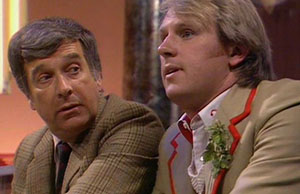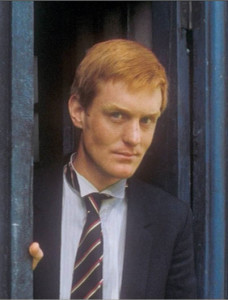 “Sometimes you have to live with the consequences of your actions.” –The Doctor
“Sometimes you have to live with the consequences of your actions.” –The Doctor
Both an old villain and an old friend return in Mawdryn Undead, a distinctly “timey-wimey” story of the sort the new series loves but Classic did only very rarely. With two stories running in parallel time zones, it’s hard to summarize the story, although it does a good job of keeping things straight as it goes on.
After discovering a luxurious spaceship flying, seemingly abandoned, in a perpetual orbit in both time and space— which it’s been doing for 3000 years— the Doctor winds up on the campus of a British boys’ school in 1983, while Tegan and Nyssa wind up at the same school six years earlier, in 1977. Among the teachers at the school is the Doctor’s old friend, Brigadier Lethbridge-Stewart, who’s retired from the military and now teaches mathematics. Tegan and Nyssa meet up with the Brig in 1977, while the Doctor encounters the slightly older version in 1983— who has mysteriously lost all memory of ever having known the Doctor, and even when he gets it back still can’t recall exactly what happened in 1977.
Meanwhile there’s a student at the school, named Turlough, who we soon realize (from a few cryptic remarks) is an extraterrestrial pretending to be an Earthling. He’s contacted by the Black Guardian, villain of the “Key to Time” series a few years back, who offers him escape from Earth if he will kill the Doctor. Before long everyone (including two versions of the Brigadier) is back on the ship, where our heroes learn it is the home of a small group of alien scientists who once stole regeneration technology from the Time Lords in an attempt to make themselves immortal— and they succeeded, but at the terrible cost of unceasing mutations and constant regeneration. Exiled by their own people to the endlessly-orbiting ship, for 3000 years they’ve desperately tried to find a way to end their suffering and die. The Doctor can help them— but only at the cost of his own ability to regenerate.
Mawdryn Undead is a very nice story from writer Peter Grimwade, who previously contributed Earthshock and (unfortunately) Time-flight. Drawing inspiration for the story from the legend of the Flying Dutchman, Grimwade does a much better writing job than his previous outing, with a carefully plotted story that handles the complexity of events in two different timelines needing to dovetail with each other and without becoming confusing to viewers. It’s a delight to see the Brigadier again (but see below for problems related to waking the Continuity Beast) and he gets a moving character story here.
We first meet the 1983 Brigadier, who not only does not remember the Doctor but also has clearly let himself go: his small house on the school grounds is cluttered and disorganized, the garden outside overgrown and neglected. The viewers then see the 1977 version— we first meet him tending the (tidy) garden that will later be overgrown, and the inside of his house is carefully clean and well-kept, as you’d expect from a career military man. The Doctor doesn’t need to see the 1977 version to know things have gone badly wrong with his old friend, and Peter Davison does a great job of showing the Doctor’s simultaneous pleasure at meeting the Brig again, and worry as he sees something is wrong. When the Brigadier admits he had a “nervous breakdown” around 6 years earlier— and so realize the 1977 version is heading for it— we can’t help but feel sorry for his confident, very-much-the-old-Brig and yet doomed earlier self, even while he can feel relieved as the 1983 version gradually finds himself again.
Mawdryn Undead was the first story actually produced for season 20 (although the third broadcast) and benefits from the always happier budget situation at the start of a Classic season. In particular, the sets for the alien spacecraft are very nice and convey the look of a luxury liner. The music is one of the better scores from the 80s-synthesizer days. It’s definitely the best of season 20 (and it was the highest rated of that year as well).
Details
- Do you still have your notes on The Great UNIT Dating Controversy that I had you keep back during the Pertwee stories? Time to pull them out as the jaws of the trap close on UNIT continuity. If you’ll recall, from various on-screen lines of dialog we had pretty firmly established that the Third Doctor joined UNIT in either 1979 or 80, and that the entire Pertwee era of stories took place over no more than a single year. However unlikely such a short time frame might seem, at least it wasn’t impossible, and it fit the “roughly ten years in the future” that the producers at the time always said the UNIT stories happened. Now, however, we get a crystal clear and impossible-to-dodge statement on screen that the Brigadier had already retired from the military and became a schoolteacher by 1977.
- The 50th Anniversary episode Day of the Doctor alluded to the Great UNIT Dating Controversy in one scene, where Kate Lethbridge-Stewart orders someone to check her father’s records for a previous incident “either in the seventies or eighties depending on the dating protocol.”
- The source of the error is that Mawdryn Undead was originally written to feature William Russell reprising the role of Ian Chesterton, one of the original season 1 companions. Since Ian was, in fact, a schoolteacher, the school setting also makes more sense. When Russell turned out to be unavailable JN-T contacted Nicholas Courtney to play the Brigadier instead— JN-T had already determined that he wanted the Brig to return sometime, so it was an easy choice. A lot of retired military officers ended up teaching school after leaving the service, so it made sense for the Brigadier to be at the school as well.
- The reason the dates weren’t rewritten when the Brig replaced Ian is that neither JN-T nor script editor Eric Saward knew the UNIT stories had originally been said to take place in the near future. Even in pre-Internet days, fandom was loud enough to swiftly make the point known at cons, in the letters column of Doctor Who Magazine, and in the pages of numerous fanzines. The producers won’t repeat the mistake— the next time UNIT appears in the Classic series it will once again be placed roughly 10 years into the future from the story’s airdate.
- UNIT continuity aside, and while it would have been fun to see Ian again, it’s just great to see Nicholas Courtney as Lethbridge-Stewart again. By appearing in Mawdryn Undead, Courtney gained the distinction of being the only actor to appear in Dr Who with (at the time) every single Doctor. (His appearance with William Hartnell in The Dalek Masterplan was as a different character, while he played Lethbridge-Stewart with all four successors.) JN-T will eventually go to considerable lengths to keep Courtney’s streak alive when new Doctors come in, but that’s a subject for future posts.
- The Black Guardian’s involvement in events remains hidden during this story, and will continue for the next two stories, forming what’s informally called the “Black Guardian Trilogy.” The idea came from JN-T’s desire to keep up the feel of an ongoing serial. He’s still got each story opening with the characters talking about the previous one, which really feels out of place since viewers are ready to move on. Like the E-space trilogy in Tom Baker’s last season, a three-story arc does a much better job of creating that ongoing feel.
 The character of Turlough, who joins the series as a new companion, was devised by JN-T two years earlier, and kept in reserve for whenever there was a chance to introduce him. Interestingly, given JN-T’s concern that the Doctor had lost a lot of his mystery, Turlough enters the series almost as mysterious as the Doctor originally was. We learn he’s an alien but nothing about where he’s from or how or why he’s on Earth (except that it’s not because he wants to be). Although we can see early on that the Doctor figures out he’s no ordinary Earthling, he chooses not to question Turlough about it. The original plan was for Turlough to be a covert villain, in league with the Black Guardian, for his entire run on the series, creating a far different dynamic than the typical companion, but it was realized early on that this would be unsustainable: it would require to many constant contrivances to keep preventing him from killing the Doctor, so instead he’s presented as increasingly reluctant to obey the Black Guardian, and after the trilogy of stories concludes he’ll be free of the Guardian’s influence. But he’ll always remain a distinctly different kind of companion, a good deal more shifty and selfish than the normal heroic sidekicks who travel with the Doctor— which makes him an interesting character. In many ways he’s a “shadow version” of the Fifth Doctor, which is what the Master should be but (as played by Anthony Ainsley) isn’t.
The character of Turlough, who joins the series as a new companion, was devised by JN-T two years earlier, and kept in reserve for whenever there was a chance to introduce him. Interestingly, given JN-T’s concern that the Doctor had lost a lot of his mystery, Turlough enters the series almost as mysterious as the Doctor originally was. We learn he’s an alien but nothing about where he’s from or how or why he’s on Earth (except that it’s not because he wants to be). Although we can see early on that the Doctor figures out he’s no ordinary Earthling, he chooses not to question Turlough about it. The original plan was for Turlough to be a covert villain, in league with the Black Guardian, for his entire run on the series, creating a far different dynamic than the typical companion, but it was realized early on that this would be unsustainable: it would require to many constant contrivances to keep preventing him from killing the Doctor, so instead he’s presented as increasingly reluctant to obey the Black Guardian, and after the trilogy of stories concludes he’ll be free of the Guardian’s influence. But he’ll always remain a distinctly different kind of companion, a good deal more shifty and selfish than the normal heroic sidekicks who travel with the Doctor— which makes him an interesting character. In many ways he’s a “shadow version” of the Fifth Doctor, which is what the Master should be but (as played by Anthony Ainsley) isn’t.- Bringing in a new companion seems to reintroduce the problem of the crowded TARDIS that required Adric to leave last season, but it’s not going to last: Nyssa will be leaving next week.
- Speaking of Nyssa, she loses her ridiculous outfit from the last story in favor of one that actually makes sense.
Next Week:
“Terminus,” 4 episodes.

